Study on the Influence of CaO on the Electrochemical Reduction of Fe2O3 in NaCl-CaCl2 Molten Salt
Abstract
:1. Introduction
2. Results and Discussion
2.1. Impact of Electrolysis Voltage
2.2. Cyclic Voltammetry Measurements
2.3. Constant Voltage Electrolysis and Phase Characterization
3. Experimental Section and Methods
3.1. Materials and Precursor Preparation
3.2. Constant Voltage Electrolysis and Cyclic Voltammetry Testing
3.3. Characterization
4. Conclusions
- (1)
- In NaCl-CaCl2 molten salt, Fe2O3 and CaO can spontaneously undergo a chemical reaction to generate Ca2Fe2O5 at 800 °C without applying electrolytic voltage. The reduction steps of Ca2Fe2O5 are Ca2Fe2O5 ⟶ Fe3O4 ⟶ FeO ⟶ Fe. Compared to the reduction of Fe2O3 alone, the addition of CaO reduces the electrolysis voltage required for the reduction to metallic Fe, facilitating the progress of the electrolysis process. Metallic Fe and CaCO3 can be generated after electrolysis at 0.6 V for 600 min.
- (2)
- Under the condition of 1 V electrolysis, the cathodic deoxidation process of Fe2O3-CaO for the production of metallic iron results in the formation of CaFe3O5, CaFe5O7, FeO, and Fe phases over time. The appearance of CaFe3O5 and CaFe5O7 phases is attributed to the interaction of Fe3O4, Ca2+, and O2− generated during the electrolysis process, as well as the subsequent reaction of Fe3O4, FeO, Ca2+, and O2− at room temperature. Under the high driving force of 1 V, the reaction time for the electrolysis of Fe2O3-CaO to Fe is reduced, and after 300 min of electrolysis, it is entirely converted to metallic Fe.
Author Contributions
Funding
Institutional Review Board Statement
Informed Consent Statement
Data Availability Statement
Conflicts of Interest
References
- Yu, X.; Tan, C. China’s pathway to carbon neutrality for the iron and steel industry. Glob. Environ. Chang. 2022, 76, 102574. [Google Scholar] [CrossRef]
- Wang, Y.X.; Liu, J.; Tang, X.L.; Wang, Y.; An, H.W.; Yi, H.H. Decarbonization pathways of China’s iron and steel industry toward carbon neutrality. Resour. Conserv. Recycl. 2023, 194, 106994. [Google Scholar] [CrossRef]
- Chang, Y.F.; Wan, F.; Yao, X.L.; Wang, J.X.; Han, Y.F.; Li, H. Influence of hydrogen production on the CO2 emissions reduction of hydrogen metallurgy transformation in iron and steel industry. Energy Rep. 2023, 9, 3057–3071. [Google Scholar] [CrossRef]
- Liu, L.T.; Zhai, R.R.; Hu, Y.D. Performance evaluation of wind-solar-hydrogen system for renewable energy generation and green hydrogen generation and storage: Energy, exergy, economic, and enviroeconomic. Energy 2023, 276, 127386. [Google Scholar] [CrossRef]
- Al-Ghussain, L.; Ahmad, A.D.; Abubaker, A.M.; Hassan, M.A. Exploring the feasibility of green hydrogen production using excess energy from a country-scale 100% solar-wind renewable energy system. Int. J. Hydrogen Energy 2022, 47, 21612–21633. [Google Scholar] [CrossRef]
- Najjar, Y.S. Hydrogen safety: The road toward green technology. Int. J. Hydrogen Energy 2013, 38, 10716–10728. [Google Scholar] [CrossRef]
- Acar, C.; Dincer, I. Review and evaluation of hydrogen production options for better environment. J. Clean. Prod. 2019, 218, 835–849. [Google Scholar] [CrossRef]
- Wang, Z.; Zhang, X.; Rezazadeh, A. Hydrogen fuel and electricity generation from a new hybrid energy system based on wind and solar energies and alkaline fuel cell. Energy Rep. 2021, 7, 2594–2604. [Google Scholar] [CrossRef]
- Tang, J.; Chu, M.S.; Li, F.; Feng, C.; Liu, Z.G.; Zhou, Y.S. Development and progress on hydrogen metallurgy. Int. J. Miner. Metall. Mater. 2020, 27, 712–723. [Google Scholar] [CrossRef]
- Sun, L.; Yin, J.; Bilal, A.R. Green financing and wind power energy generation: Empirical insights from China. Rebew. Energy 2023, 206, 820–827. [Google Scholar] [CrossRef]
- Nian, V.; Chou, S.K. The state of nuclear power two years after Fukushima–The ASEAN perspective. Appl. Energy 2014, 136, 838–848. [Google Scholar] [CrossRef]
- Nian, V.; Mignacca, B.; Locatelli, G. Policies toward net-zero: Benchmarking the economic competitiveness of nuclear against wind and solar energy. Appl. Energy 2014, 320, 119275. [Google Scholar] [CrossRef]
- Allanore, A. Features and challenges of molten oxide electrolytes for metal extraction. J. Electrochem. Soc. 2014, 162, E13. [Google Scholar] [CrossRef]
- Allanore, A.; Lavelaine, H.; Valentin, G.; Birat, J.P.; Lapicque, F. Iron Metal Production by Bulk Electrolysis of Iron Ore Particles in Aqueous Media. J. Electrochem. Soc. 2008, 155, 125–129. [Google Scholar] [CrossRef]
- Tang, D.; Yin, H.; Xiao, W.; Zhu, H.; Mao, X.; Wang, D. Reduction mechanism and carbon content investigation for electrolytic production of iron from solid Fe2O3 in molten K2CO3–Na2CO3 using an inert anode. J. Electroanal. Chem. 2013, 689, 109–116. [Google Scholar] [CrossRef]
- Sadoway, D.R. New opportunities for metals extraction and waste treatment by electrochemical processing in molten salts. J. Mater. Res. 1995, 10, 487–492. [Google Scholar] [CrossRef]
- Zhang, K.; Jiao, H.; Zhou, Z.; Jiao, S.; Zhu, H. Electrochemical behavior of Fe (III) ion in CaO-MgO-SiO2-Al2O3-NaF-Fe2O3 melts at 1673 K. J. Electrochem. Soc. 2016, 163, 710. [Google Scholar] [CrossRef]
- Chen, G.Z.; Fray, D.J.; Farthing, T.W. Direct electrochemical reduction of titanium dioxide to titanium in molten calcium chloride. Nature 2000, 407, 361–364. [Google Scholar] [CrossRef]
- Xi, X.L.; Feng, M.; Zhang, L.W.; Nie, Z.R. Applications of molten salt and progress of molten salt electrolysis in secondary metal resource recovery. Int. J. Miner. Metall. Mater. 2020, 27, 1599–1617. [Google Scholar] [CrossRef]
- Li, M.; Liu, C.Y.; Ding, A.T.; Xiao, C.L. A review on the extraction and recovery of critical metals using molten salt electrolysis. J. Environ. Chem. Eng. 2023, 11, 109746. [Google Scholar] [CrossRef]
- Li, H.; Jia, L.; Liang, J.L.; Yan, H.Y.; Cai, Z.Y.; Reddy, R.G. Study on the Direct Electrochemical Reduction of Fe2O3 in NaCl-CaCl2 Melt. Int. J. Electrochem. Sci. 2019, 14, 11267–11278. [Google Scholar] [CrossRef]
- Li, H.; Jia, L.; Cao, W.G.; Liang, J.L.; Wang, L.; Yan, H.Y. The electrochemical reduction mechanism of Fe3O4 in NaCl-CaCl2 melts. Int. J. Chem. React. Eng. 2021, 19, 43–52. [Google Scholar] [CrossRef]
- Fray, D.; Schwandt, C. Aspects of the application of electrochemistry to the extraction of titanium and its applications. Mater. Trans. 2017, 58, 306–312. [Google Scholar] [CrossRef]
- Chen, G.Z.; Gordo, E.; Fray, D.J. Direct electrolytic preparation of chromium powder. Metall. Mater. Trans. B 2004, 35, 223–233. [Google Scholar] [CrossRef]
- Liu, Z.W.; Zhang, H.L.; Pei, L.L.; Shi, Y.L.; Cai, Z.H.; Xu, H.B.; Zhang, Y. Direct electrolytic preparation of chromium metal in CaCl2–NaCl eutectic salt. Trans. Nonferrous Met. Soc. China 2018, 28, 376–384. [Google Scholar] [CrossRef]
- Huan, S.X.; Wang, Y.W.; Peng, J.P.; Di, Y.Z.; Li, B.; Zhang, L.D. Recovery of aluminum from waste aluminum alloy by low-temperature molten salt electrolysis. Miner. Eng. 2020, 154, 106396. [Google Scholar] [CrossRef]
- Chen, Y.F.; Wang, M.Y.; Lv, A.J.; Zhao, Z.H.; An, J.L.; Zhang, J.T.; Tu, J.G.; Jiao, S.Q. Green preparation of vanadium carbide through one-step molten salt electrolysis. Ceram Int. 2021, 47, 28203–28209. [Google Scholar] [CrossRef]
- An, J.L.; Wang, M.Y.; Jia, Y.Z.; Chen, Y.F.; Jiao, S.Q. Facile preparation of metallic vanadium from consumable V2CO solid solution by molten salt electrolysis. Sep. Purif. Technol. 2022, 295, 121361. [Google Scholar] [CrossRef]
- Chang, C.; Tu, J.G.; Chen, Y.F.; Wang, M.Y.; Jiao, S.J. Electro-deoxidation behavior of solid SeO2 in a low-temperature molten salt. Chem. Commun. 2022, 58, 9108–9111. [Google Scholar] [CrossRef]
- Zhu, X.; Li, L.; Song, W.C.; Zhang, D.F.; Ma, S.R.; Qiu, K.H. Electrochemical synthesis of Ti–Al–V alloy by chlorination of Ti2O3 and V2O3 in AlCl3-containing molten chloride salt. J. Mater. Res. Technol. 2021, 13, 1243–1253. [Google Scholar] [CrossRef]
- Cao, X.Z.; Li, Q.Y.; Shi, Y.Y.; Wu, D.; Xue, X.X. Preparation of V-4Cr-4Ti Alloys from Mixed Oxides via Electro-Deoxidation Process in Molten Salt. Metals 2022, 10, 1067. [Google Scholar] [CrossRef]
- Li, S.S.; Zou, X.L.; Zheng, K.; Lu, X.G.; Chen, C.Y.; Li, X.; Xu, Q.; Zhou, Z.F. Electrosynthesis of Ti5Si3, Ti5Si3/TiC and Ti5Si3/Ti3SiC2 from Ti-bearing blast furnace slag in molten CaCl2. Metall. Mater. Trans. B 2018, 49, 790–802. [Google Scholar] [CrossRef]
- Sure, J.; Vishnu, D.S.M.; Kumar, R.V.; Schwandt, C. Molten salt electrochemical synthesis, heat treatment and microhardness of Ti-5Ta-2Nb alloy. Mater. Trans. 2019, 60, 391–399. [Google Scholar] [CrossRef]
- Hu, D.; Xiao, W.; Chen, G.Z. Near-net-shape production of hollow titanium alloy components via electrochemical reduction of metal oxide precursors in molten salts. Metall. Mater. Trans. B 2013, 44, 272–282. [Google Scholar] [CrossRef]
- Yang, X.; Jiao, H.; Wang, M.Y.; Jiao, S.Q. Direct preparation of V–Al alloy by molten salt electrolysis of soluble NaVO3 on a liquid Al cathode. J. Alloys Compd. 2019, 779, 22–29. [Google Scholar]
- Zhua, F.X.; Li, K.H.; Song, W.C.; Li, L.; Zhang, D.F.; Qiu, K.H. Composition and structure of Ti–Al alloy powders formed by electrochemical co-deposition in KCl–LiCl–MgCl2–TiCl3–AlCl3 molten salt. Intermetallics 2021, 139, 107341. [Google Scholar] [CrossRef]
- Sure, J.; Vishnu, D.S.M.; Schwandt, C. Direct electrochemical synthesis of high-entropy alloys from metal oxides. Appl. Mater. Today 2017, 9, 111–121. [Google Scholar] [CrossRef]
- Schwandt, C.; Doughty, G.R.; Fray, D.J. The FFC-Cambridge Process for Titanium Metal Winning; Trans Tech Publications Ltd.: Stafa-Zurich, Switzerland, 2010; Volume 436, pp. 13–25. [Google Scholar]
- Jiang, K.; Hu, X.; Ma, M.; Wang, D.; Qiu, G.; Jin, X.; Chen, G.Z. “Perovskitization”-Assisted electrochemical reduction of solid TiO2 in Molten CaCl2. Angew. Chemie. 2006, 118, 442–446. [Google Scholar] [CrossRef]
- Descallar-Arriesgado, R.F.; Kobayashi, N.; Kikuchi, T.; Suzuki, R.O. Calciothermic reduction of NiO by molten salt electrolysis of CaO in CaCl2 melt. Electrochim. Acta 2011, 56, 8422–8429. [Google Scholar] [CrossRef]
- Schwandt, C. On the nature of the current and the absence of an IR-drop in an FFC-Cambridge-type electro-deoxidation cell. Electrochim. Acta 2018, 280, 114–120. [Google Scholar] [CrossRef]
- Pang, Z.Y.; Li, X.; Zhang, X.Q.; Li, J.J.; Wang, S.J.; Xiong, X.L.; Li, G.S.; Qian., X.; Zhou, Z.F.; Zou, X.L.; et al. Molten salt electrosynthesis of silicon carbide nanoparticles and their photoluminescence property. Trans. Nonferrous Met. Soc. China 2022, 32, 3790–3800. [Google Scholar] [CrossRef]
- Schwandt, C.; Fray, D.J. Determination of the kinetic pathway in the electrochemical reduction of titanium dioxide in molten calcium chloride. Electrochim. Acta 2005, 51, 66–76. [Google Scholar] [CrossRef]
- Liang, J.L.; Wang, D.B.; Wang, L.; Li, H.; Cao, W.G.; Yan, H.Y. Electrochemical process for recovery of metallic Mn from waste LiMn2O4-based Li-ion batteries in NaCl−CaCl2 melts. Int. J. Min. Met. Mater. 2022, 29, 473–478. [Google Scholar] [CrossRef]
- Li, H.; Xue, C.L.; Yang, Y.; Liang, J.L. Preparation of Fe3Si and FeSi intermetallic compounds from copper slag by electrochemical method. J. Iron Steel Res. Int. 2023, 30, 213–221. [Google Scholar] [CrossRef]
- Zhou, Z.G.; Hua, Y.X.; Xu, C.Y.; Li, J.; Li, Y.; Zhang, Q.B.; Zhang, Y.D.; Kuang, W.H. Synthesis of micro-FeTi powders by direct electrochemical reduction of ilmenite in CaCl2-NaCl molten salt. Ionics 2016, 23, 213–221. [Google Scholar] [CrossRef]
- Wu, T.; Ma, X.; Jin, X. Preparation of vanadium powder and vanadium-titanium alloys by the electroreduction of V2O3 and TiO2 powders. Mater. Res. 2016, 31, 405–417. [Google Scholar] [CrossRef]
- Abdelkader, A.M.; Fray, D.L. Electro-deoxidization of hafnium dioxide and niobia-doped hafnium dioxide in molten calcium chloride. Electrochim. Acta 2012, 64, 10–16. [Google Scholar] [CrossRef]
- Lee, M.J.; Noh, J.S.; Kim, K.Y.; Lee, J.H. Electrochemical deoxidization of ZrSiO4 in molten calcium chloride. Phys. Met. Metallogr. 2014, 115, 1356–1361. [Google Scholar] [CrossRef]
- Bagus, P.S.; Nelin, C.J.; Brundle, C.R.; Vincent Crist, B.; Lahiri, N.; Rosso, K.M. Combined multiplet theory and experiment for the Fe 2p and 3p XPS of FeO and Fe2O3. Chem. Phys. 2021, 154, 094709. [Google Scholar] [CrossRef]
- Qu, Z.F.; Hu, M.L.; Gao, L.Z.; Lai, P.S.; Bai, C.G. Preparation of Titanium Foams Through Direct Electrolysis of the Sintered CaO-TiO2 in Molten Salt CaCl2. In 9th International Symposium on High-Temperature Metallurgical Processing; Springer International Publishing: Berlin/Heidelberg, Germany, 2018; pp. 225–232. [Google Scholar]
- Xu, Y.; Zhao, G.; Cai, Y. Preparation of Titanium by Electro-deoxidation of CaTiO3 in a Molten CaCl2-NaCl Salt. Int. J. Electrochem. Sci. 2021, 16, 211022. [Google Scholar] [CrossRef]
- Chen, G.Z.; Fray, D.J. Understanding the electro-reduction of metal oxides in molten salts. In Light Metals-Warrendale-Proceedings; TMS: Charlotte, NC, USA, 2004; pp. 881–886. [Google Scholar]
- Yan, X.Y.; Fray, D.J. Production of niobium powder by direct electrochemical reduction of solid Nb2O5 in a eutectic CaCl2-NaCl melt. Metall. Mater. Trans. B 2002, 33, 685–693. [Google Scholar] [CrossRef]
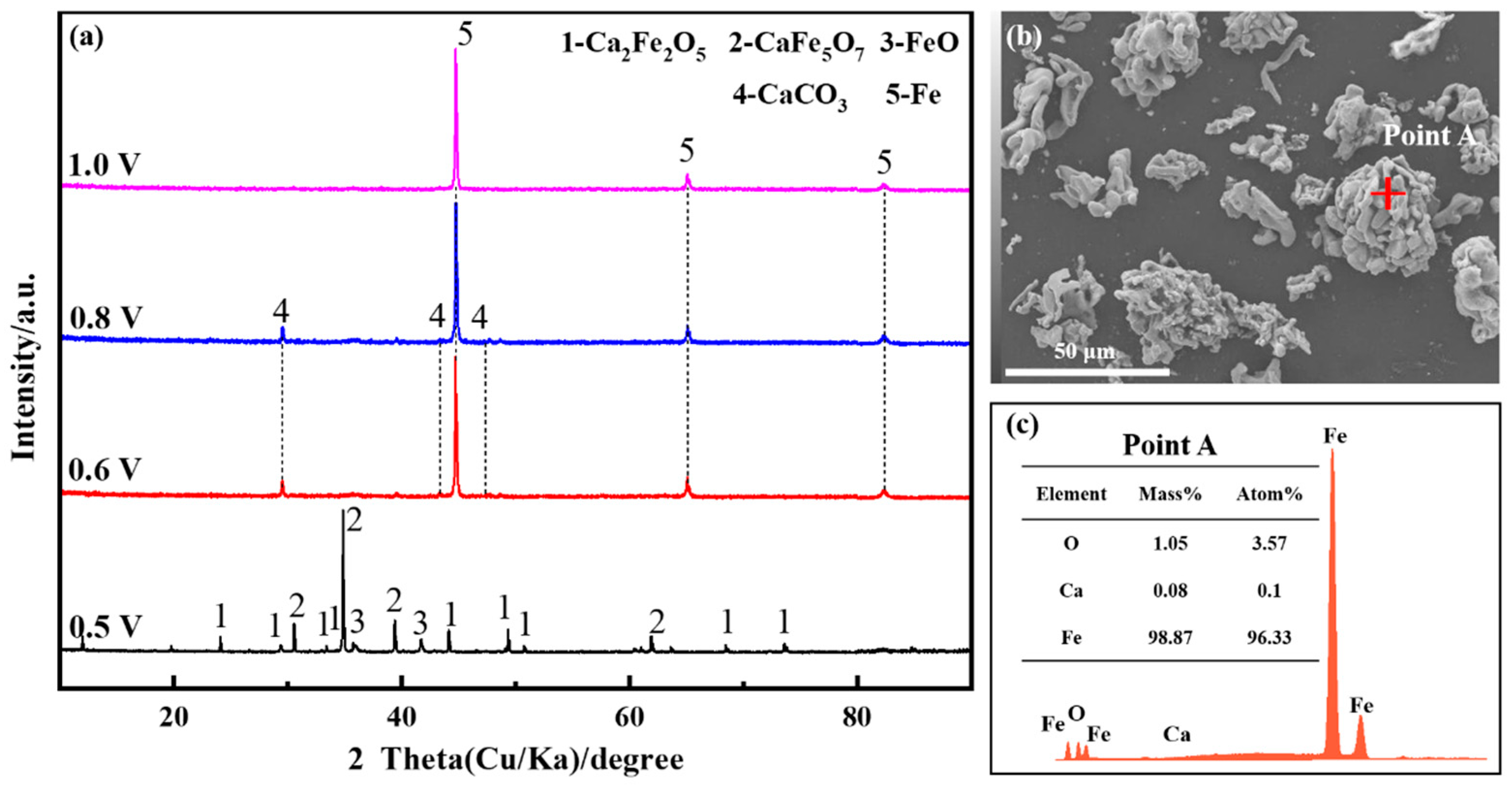
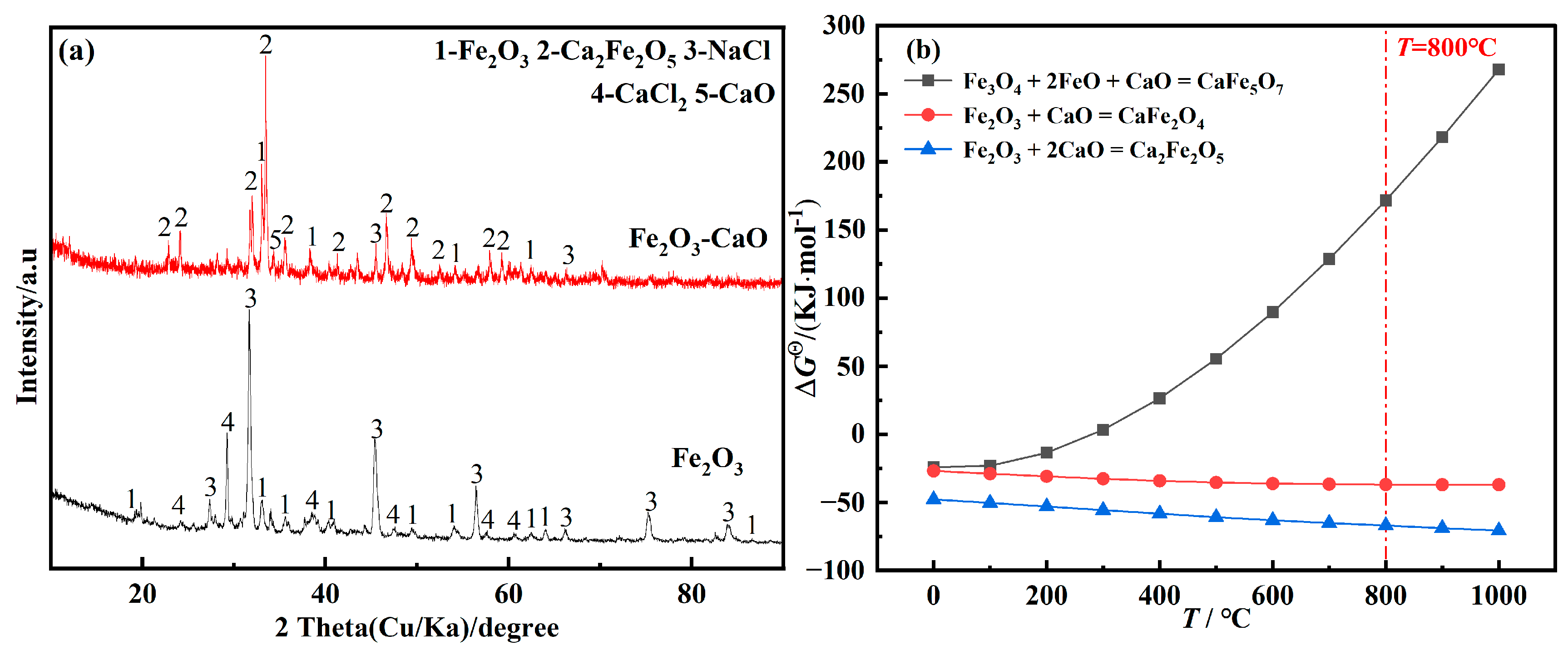
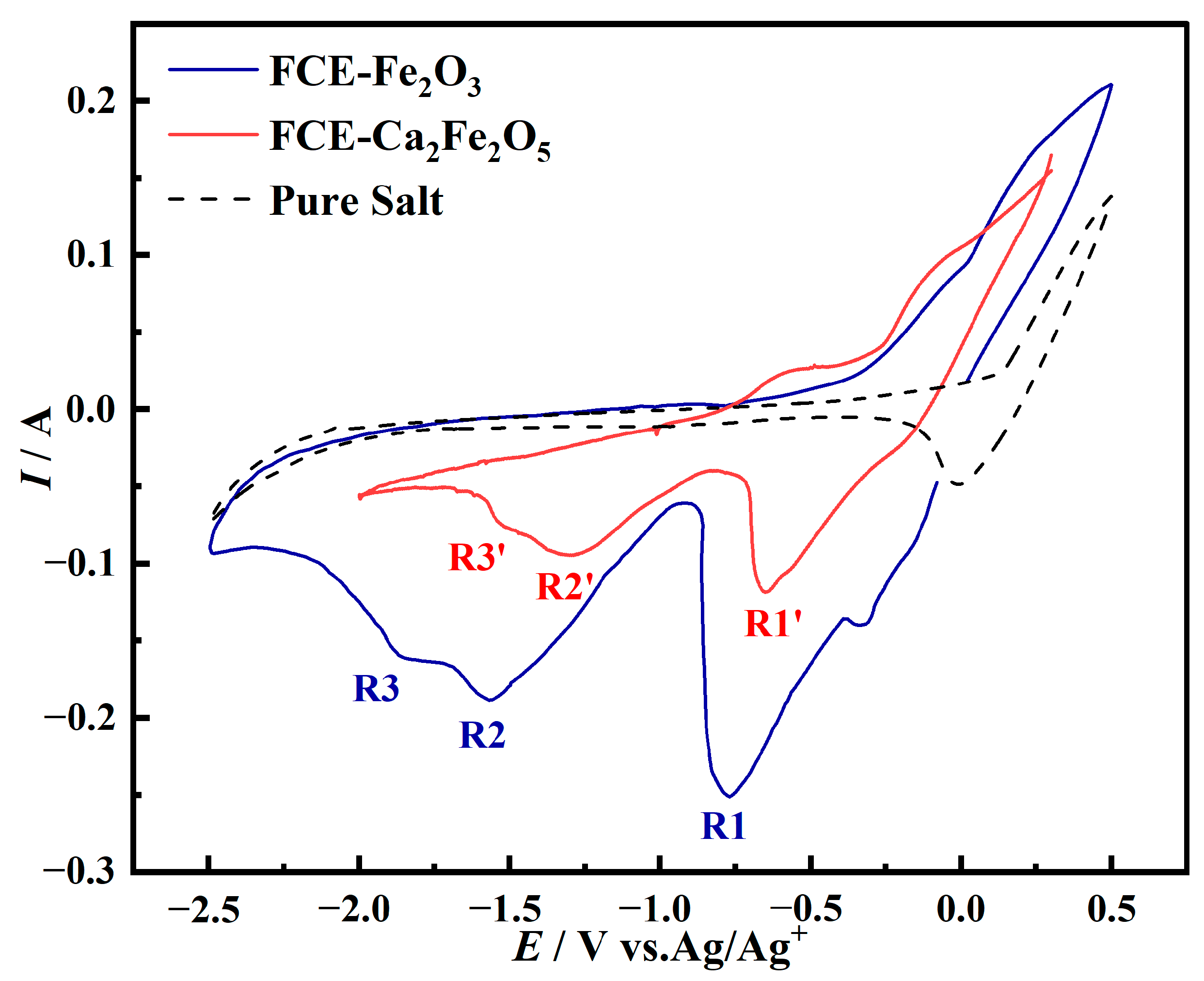

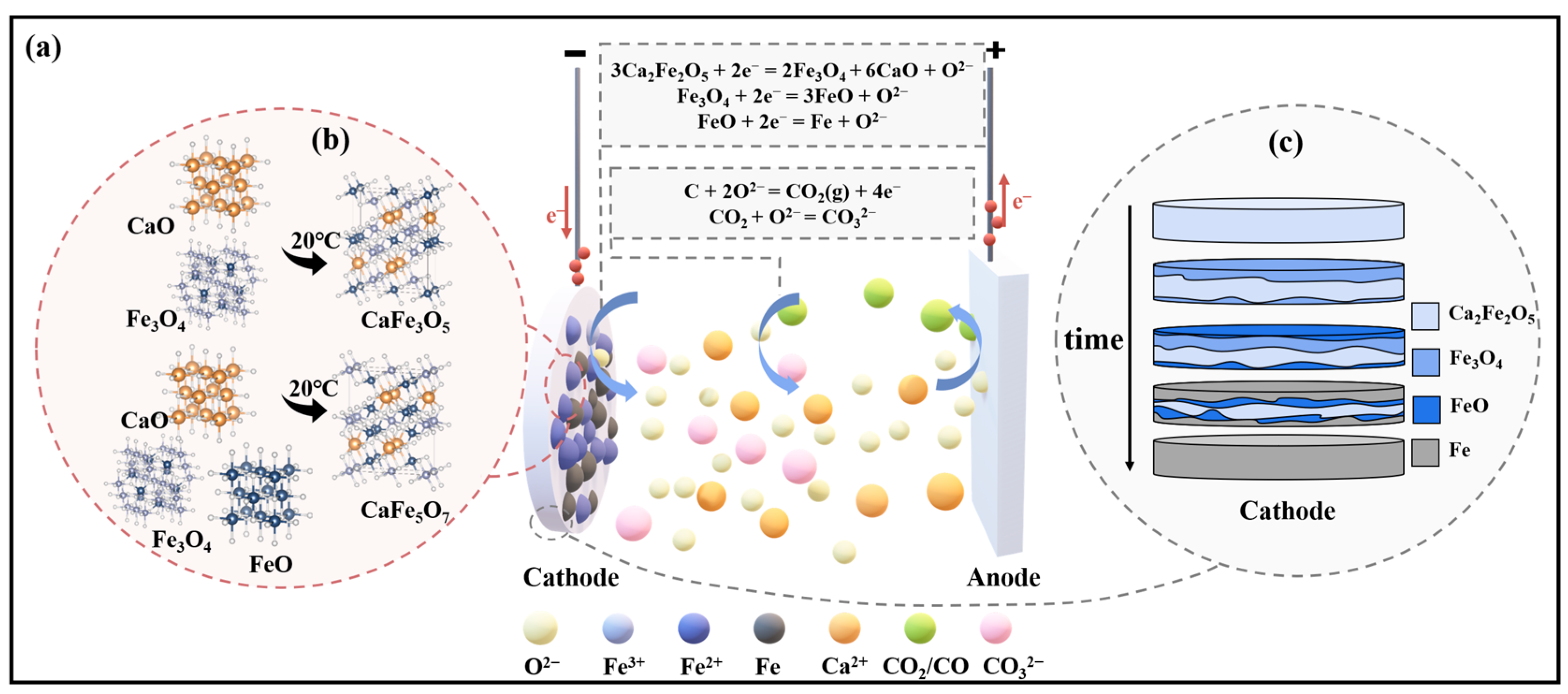
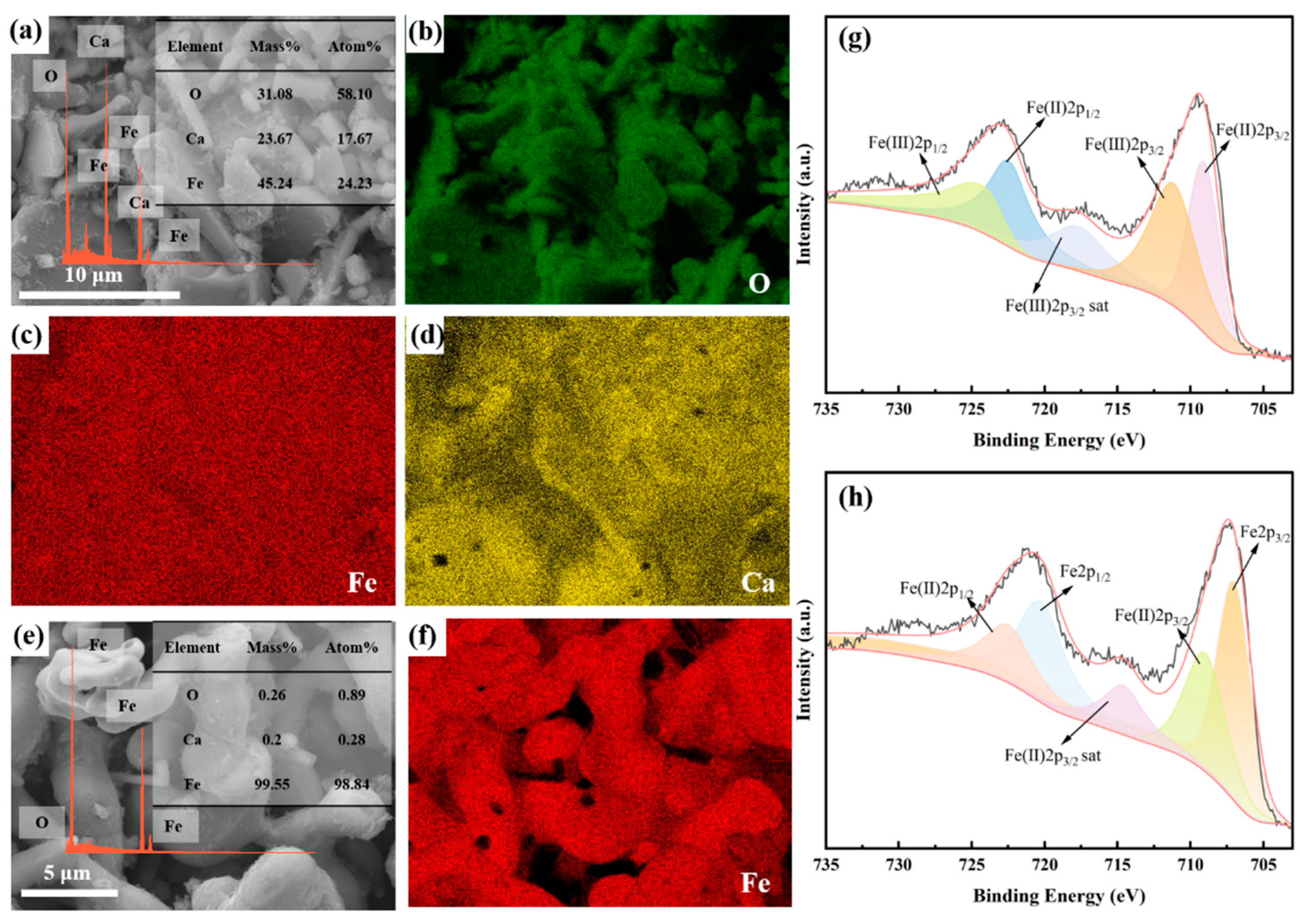
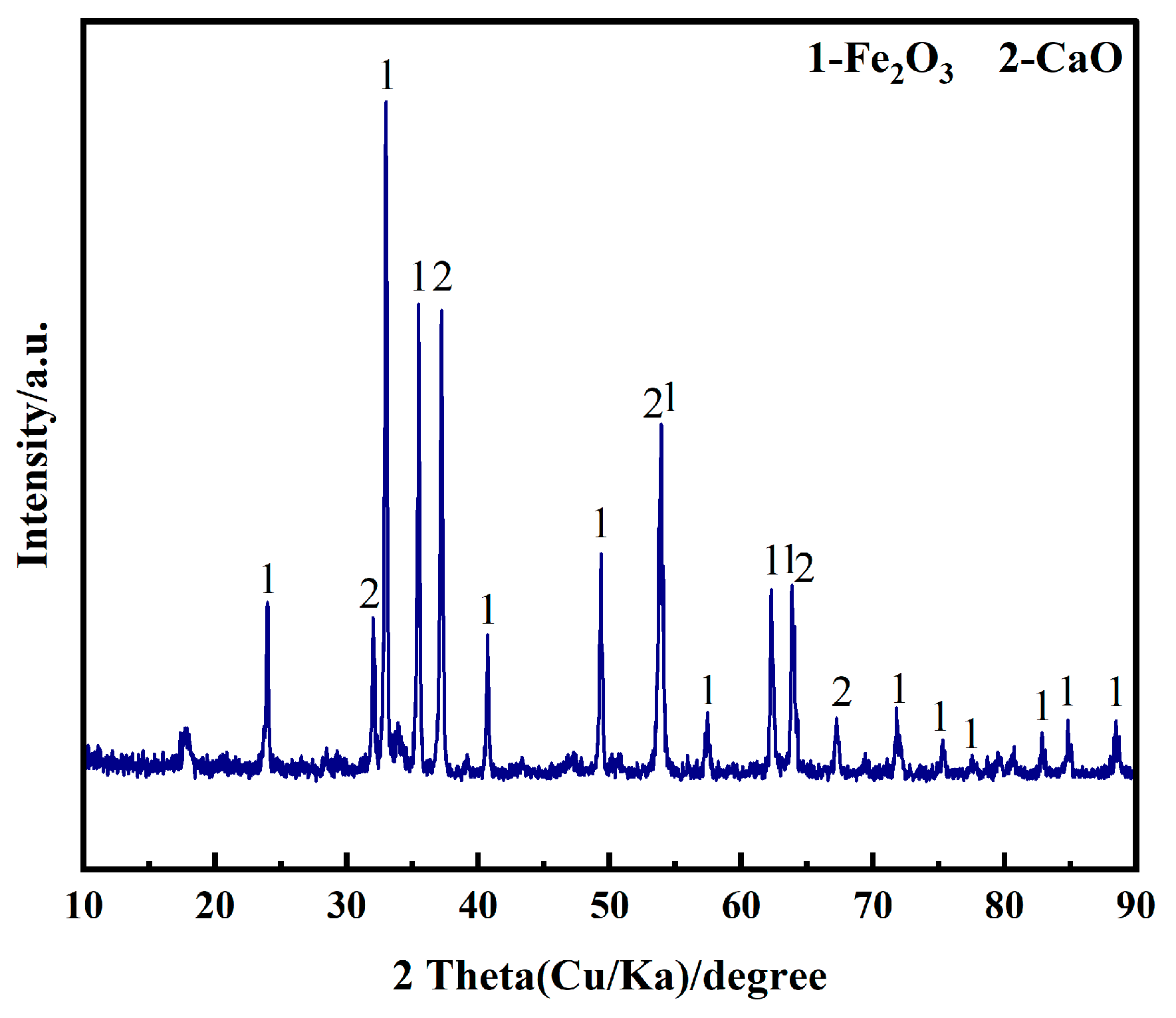
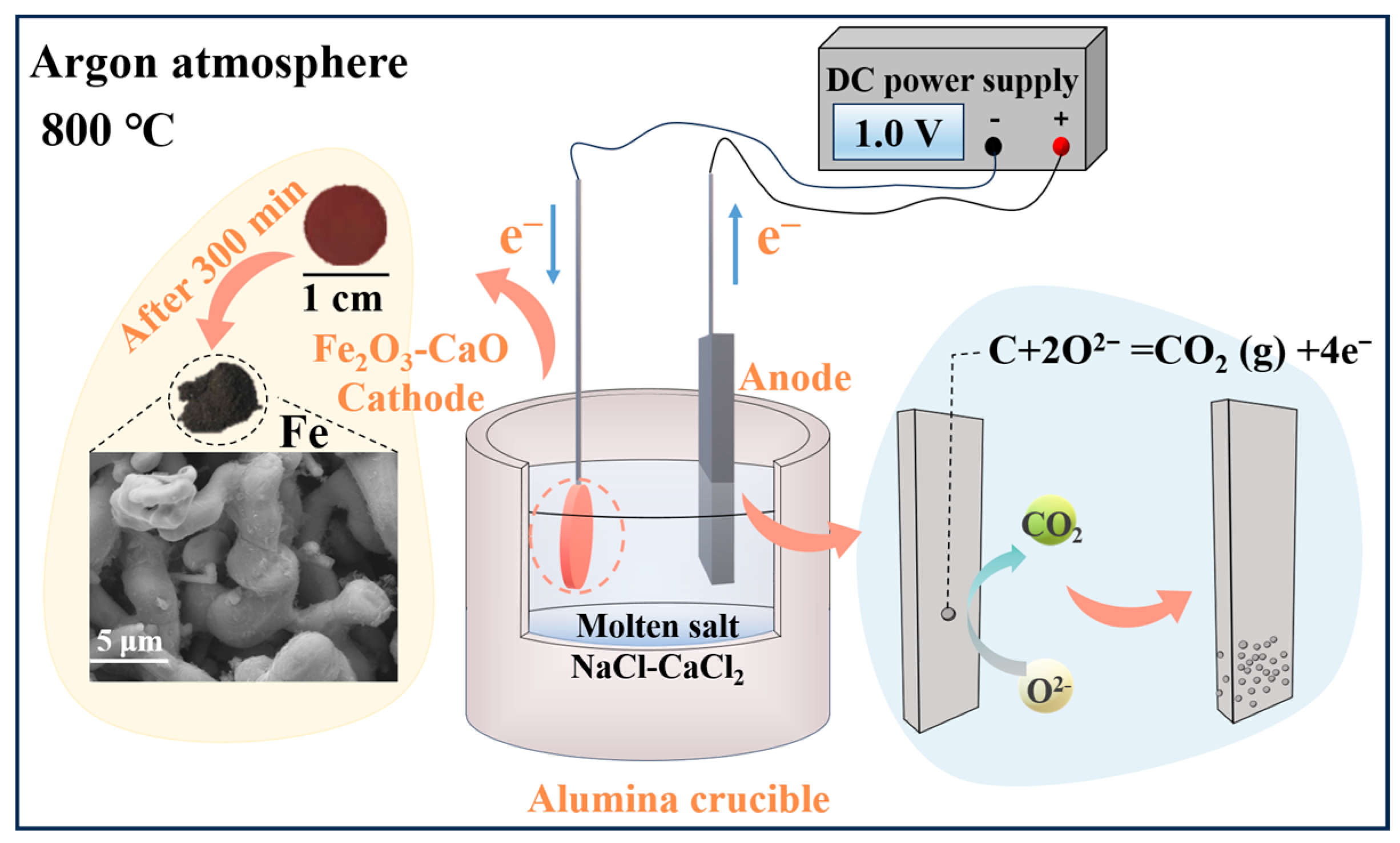
Disclaimer/Publisher’s Note: The statements, opinions and data contained in all publications are solely those of the individual author(s) and contributor(s) and not of MDPI and/or the editor(s). MDPI and/or the editor(s) disclaim responsibility for any injury to people or property resulting from any ideas, methods, instructions or products referred to in the content. |
© 2023 by the authors. Licensee MDPI, Basel, Switzerland. This article is an open access article distributed under the terms and conditions of the Creative Commons Attribution (CC BY) license (https://creativecommons.org/licenses/by/4.0/).
Share and Cite
Li, H.; Song, L.; Liang, J.; Huo, D.; Cao, W.; Liu, C. Study on the Influence of CaO on the Electrochemical Reduction of Fe2O3 in NaCl-CaCl2 Molten Salt. Molecules 2023, 28, 8103. https://doi.org/10.3390/molecules28248103
Li H, Song L, Liang J, Huo D, Cao W, Liu C. Study on the Influence of CaO on the Electrochemical Reduction of Fe2O3 in NaCl-CaCl2 Molten Salt. Molecules. 2023; 28(24):8103. https://doi.org/10.3390/molecules28248103
Chicago/Turabian StyleLi, Hui, Lingyue Song, Jinglong Liang, Dongxing Huo, Weigang Cao, and Chang Liu. 2023. "Study on the Influence of CaO on the Electrochemical Reduction of Fe2O3 in NaCl-CaCl2 Molten Salt" Molecules 28, no. 24: 8103. https://doi.org/10.3390/molecules28248103





